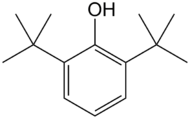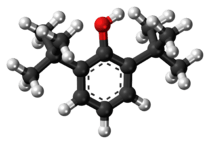2,6-Di-tert-butylphenol
 | |
 | |
| Names | |
|---|---|
| Preferred IUPAC name
2,6-Di-tert-butylphenol | |
| Other names
2,6-Bis(1,1-dimethylethyl)phenol Dibutylphenol 2,6-Bis(tert-butyl)phenol 2,6-Di(1,1-dimethylethyl)phenol 2,6-DTBP Ethanox 701 Ethyl 701 Ethyl AN 701 Irganox L 140 Isonox 103 TK 12891 | |
| Identifiers | |
| 128-39-2 | |
| 3D model (Jmol) | Interactive image |
| ChEBI | CHEBI:131421 |
| ChEMBL | ChEMBL281071 |
| ChemSpider | 29135 |
| ECHA InfoCard | 100.004.441 |
| |
| |
| Properties | |
| Appearance | Low-melting colourless solid |
| Melting point | 34 to 37 °C (93 to 99 °F; 307 to 310 K) |
| Boiling point | 253 °C (487 °F; 526 K) |
| Hazards | |
| R-phrases | R22 R36 R37 R38 |
| S-phrases | S22 S36 |
| Except where otherwise noted, data are given for materials in their standard state (at 25 °C [77 °F], 100 kPa). | |
| | |
| Infobox references | |
2,6-Di-tert-butylphenol is an organic compound with the structural formula 2,6-((CH3)3C)2C6H3OH. This colorless solid alkylated phenol and its derivatives are used industrially as UV stabilizers and antioxidants for hydrocarbon-based products ranging from petrochemicals to plastics. Illustrative of its usefulness, it prevents gumming in aviation fuels.
Production
2,6-Di-tert-butylphenol is prepared by the reaction of phenol with isobutene catalyzed by aluminium phenoxide: [1]
- C6H5OH + 2 CH2=C(CH3)2 → ((CH3)3C)2C6H3OH
In this way, approximately 2.5M kg/y are produced.
Applications
2,6-Di-tert-butylphenol is a precursor to more complex compounds used as antioxidants and light-protection agents. Representative derivatives include 3,5-di-tert-butyl-4-hydroxybenzyl chloride (CAS# 955-01-1), 3,5-di-tert-butyl-4-hydroxybenzyl alcohol (CAS# 88-26-6), and methyl-3-(3,5-di-tert-butyl-4-hydroxyphenyl)- propionate (CAS# 6386-38-5). Such derivatives are prepared from 2,6-di-tert-butylphenol by chloromethylation and hydroxymethylation using formaldehye and alkylation with acrylic acid.
Safety and regulation
The LD50 is 9200 mg/kg, indicating a low toxicity.[1]
2,6-Di-tert-butylphenol is covered by the U.S. Department of Transportation Code of Federal Regulations 49 CFR 172.101, Appendix B (20 Dec 2004). This substance is designated by the U.S. Department of Transportation (DOT) as a marine pollutant.
See also
References
- 1 2 Helmut Fiege, Heinz-Werner Voges, Toshikazu Hamamoto, Sumio Umemura, Tadao Iwata, Hisaya Miki, Yasuhiro Fujita, Hans-Josef Buysch, Dorothea Garbe, Wilfried Paulus "Phenol Derivatives" in Ullmann's Encyclopedia of Industrial Chemistry, Wiley-VCH, Weinheim, 2002. doi:10.1002/14356007.a19_313 Article Online Posting Date: June 15, 2000.